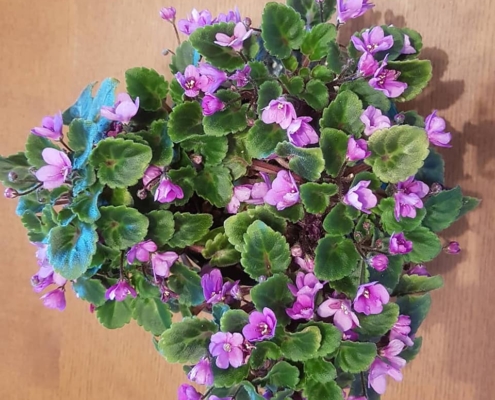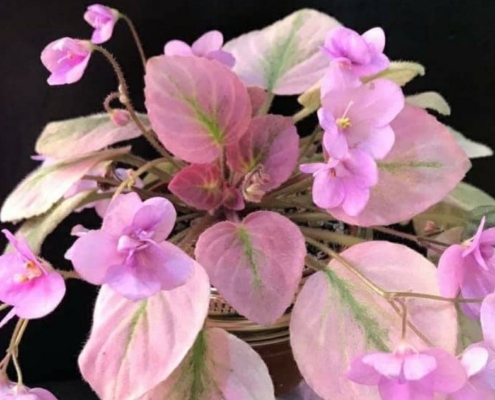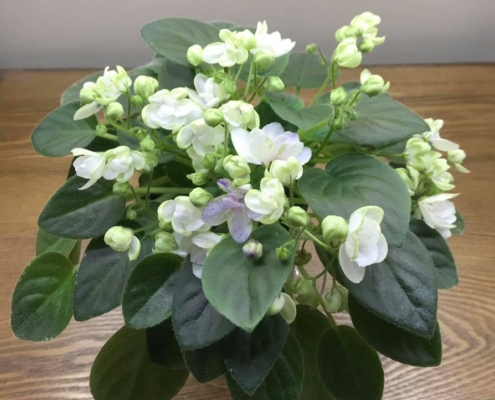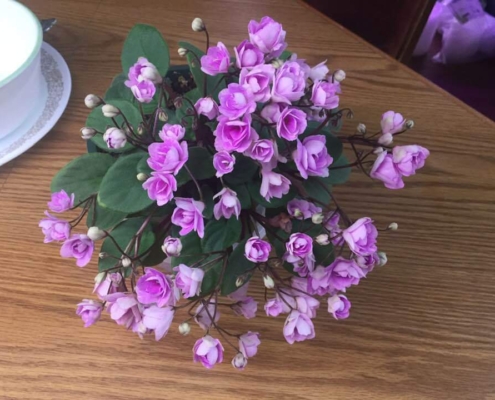Introduction to Trailers
by Lisa Kampel (moderator of the African Violet Trailers – a whole new ball game! on Facebook)
Trailers are great fun to grow, and they do just as well in natural light as they do under fluorescent light. Soil and fertilizer requirements are the same as other African violets. A light, porous soil is best. Look for fertilizers which are low urea, and use at ¼ teaspoon to a gallon of water.
Trailing violets originated in the species. There are several varieties that trail naturally. Trailing is an inbred trait and should not be confused with violets that genetically should have only one crown but have been allowed to sucker. True trailers often have more space between leaves on the main stem. This space allows them to have multiple crowns that are not too tightly packed.
Trailers may be classified as micro-miniature, miniature, semiminiature or standard according to the size of the individual leaves. The overall size of a mature trailer, regardless of its size classification, can be quite large. They are floriferous and come in most of the flower types/colors of other African violets.
Trailers have two distinct growing habits. Some trailers have short internodes or short distances between successive leaves along the stem. They produce clumping or upright growth habits. Others have long internodes and are more vining, with a sprawling growth habit.
In order for a trailer to be a show plant, it must be a single plant with no less than three crowns. Trailers are judged on form, not symmetry. The goal is to achieve a pleasing form. Try to anticipate the ultimate form of the plant and work towards that goal. Blooms should be spaced evenly around the plant from all main crowns. One crown should not have leaves noticeably different in size than the other crowns. All the crowns should be uniform in size and shape. The plant should be well groomed and in great condition, clean with no faded blooms, yellow, or marred leaves.
Trailers may be grown in different ways.
- One method keeps a trailing violet in a pot that is approximately one‐third the overall diameter of the plant. This allows the plant to grow out over the sides of the pot. The crowns are often pinched out to encourage secondary growth between leaves so a pretty form develops. In this method, the main stems of the trailing growth are not allowed to come in contact with the potting mix.
- A second method of growing, called the Japanese method, is to place the plant into a broad shallow pot or tray. As the stems elongate, they are positioned/pinned to the soil. This results in a mound that extends just to the edge of the pot. Plants grown using the Japanese method can grow to be quite large.
However, no matter which method you use the best way to produce bloom is to keep the plant pot-bound and give it plenty of light.
Grooming trailers is a necessity. All violets need to occasionally have their leaves washed and spent blossoms removed and that is also true for trailers. Grooming leaves is different for trailers. Leaves should all be the same size according to their stage of growth, but trailers tend to develop immature and off‐sized leaves that need to be removed. Also marred, yellowing or old limp leaves need to be removed. You may groom with a pair of tweezers, or simply cut or pinch with your fingers.
An important grooming technique is the removal of leaves to expose center stems. This results in the growth of more dormant crowns. Removal of leaves that crowd or cover other crowns allows the crowns to grow more evenly. Another technique is staking or pinning to train or balance the growth of crowns. After removal of the leaves, small wood stakes or hairpins are used to move the crown to promote proper form.
What can be done with a plant that has minimal branching or one dominate leader? First, trim back the dominate crown. Then, thin the leaves to expose the stem to more light to encourage branching. You can also pinch out the crown to encourage the development of new crowns.
Above all, enjoy your trailer!






